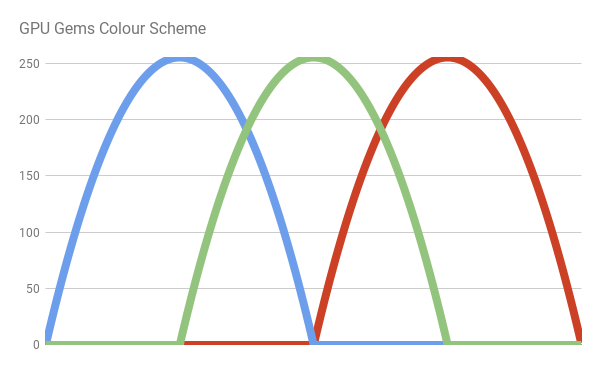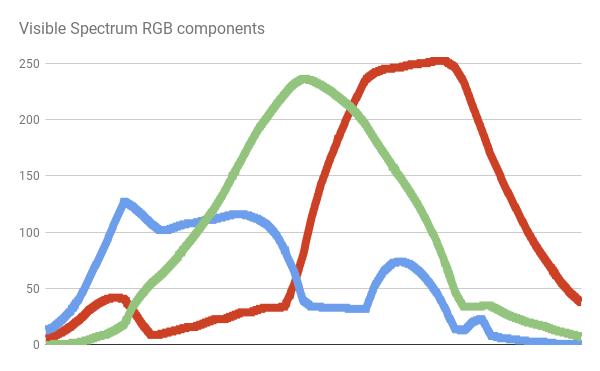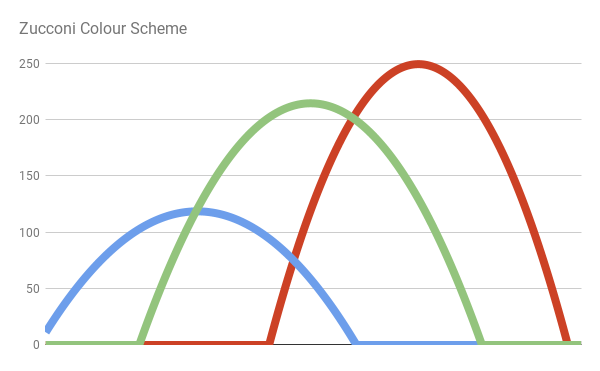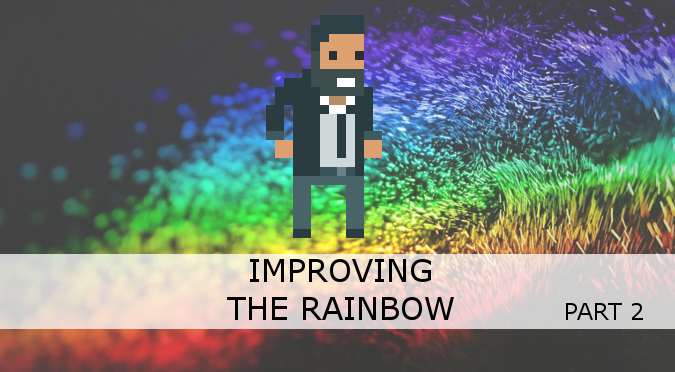In the previous part of this tutorial, Improving the Rainbow – Part 1, we have seen different techniques to reproduce the colours of the rainbow procedurally. Solving this problem efficiently will allow us to simulate physically based reflections with a much higher fidelity.
The purpose of this post is to introduce a novel approach that yields better results than any of the previous solutions, without using any branching.

You can find the complete series here:
- Part 1. The Nature of Light
- Part 2. Improving the Rainbow (Part 1)
- Part 3. Improving the Rainbow (Part 2)
- Part 4. Understanding Diffraction Grating
- Part 5. The Mathematics of Diffraction Grating
- Part 6. CD-ROM Shader: Diffraction Grating (Part 1)
- Part 7. CD-ROM Shader: Diffraction Grating (Part 2)
- Part 8. Iridescence on Mobile
- Part 9. The Mathematics of Thin-Film Interference
- Part 10. Car Paint Shader: Thin-Film Interference
A link to download the Unity project used in this series is also provided at the end of the page.
Introduction
In the previous post, we have analysed four different techniques to convert wavelengths in the visible range of the electromagnetic spectrum (400-700 nanometers) to their respective colours.
Three of those solutions (JET, Bruton and Spektre) heavily relied on if statements. While that is a standard practice in C#, branching in a shader is notoriously bad. The approach discussed in the GPU Gems book is the only one that did not use any branching. Despite that, it did not provide the best approximation for the colours in the visible spectrum.
| Name | Gradient |
| GPU Gems |  |
| Visible |  |
The post will show an optimised version of the colour scheme firstly described in the GPU Gems book.
The “Bump” Colour Scheme
The original colour scheme introduced in the GPU Gems book used three parabolas (called “bumps” by the author) to replicate the distribution of R, G and B colours in the rainbow.

Each bump is described by the following equation:
![]()
Each wavelength ![]() in the range [400, 700] is associated with a normalised value
in the range [400, 700] is associated with a normalised value ![]() in the range [0,1]. Then, the R, G and B components of the visible spectrum are given by:
in the range [0,1]. Then, the R, G and B components of the visible spectrum are given by:
![]()
![]()
![]()
All the numerical values have been been chosen by the author experimentally. You can see, however, how poorly they map to the actual distribution of colours.

Optimising for Quality
The first solution I personally came up with uses exactly the same equations of the GPU Gems colour scheme. However, I have optimised all the numerical values so that the final range of colours matches as closely as possible with the actual colours from the visible spectrum.
The result converges to the following solution:

And yields a much more realistic result:
| Name | Gradient |
| GPU Gems |  |
| Zucconi |  |
| Visible |  |
Like the original solution, this new approach is branchless. Hence, it is perfect for shaders. This is the code:
// Based on GPU Gems
// Optimised by Alan Zucconi
inline fixed3 bump3y (fixed3 x, fixed3 yoffset)
{
float3 y = 1 - x * x;
y = saturate(y-yoffset);
return y;
}
fixed3 spectral_zucconi (float w)
{
// w: [400, 700]
// x: [0, 1]
fixed x = saturate((w - 400.0)/ 300.0);
const float3 cs = float3(3.54541723, 2.86670055, 2.29421995);
const float3 xs = float3(0.69548916, 0.49416934, 0.28269708);
const float3 ys = float3(0.02320775, 0.15936245, 0.53520021);
return bump3y ( cs * (x - xs), ys);
}
❓ Tell me more about this solution!Those are the parameters necessary to replicate my results:
- Algorithm: L-BFGS-B
- Tolerance:

- Iterations:

- Weighted MSE:
- Fitting
- Image: Linear Visible Spectrum
- Wavelength range: from
 to
to 
- Range resized to:
 pixels
pixels
- Initial solution:
- Solution:
Improving the Rainbow
If we look closer at the distribution of colours in the visible spectrum, we can notice that parabolas cannot really capture the R, G and B colour curves. A slightly better approach is to use six parabolas, instead of just three. Fitting two bumps for each primary component, we can get a much better approximation. The difference is really visible in the violet part of the spectrum.

The difference is really visible in the violet and orange parts of the spectrum:
| Name | Gradient |
| Zucconi |  |
| Zucconi6 |  |
| Visible |  |
Here is the code:
// Based on GPU Gems
// Optimised by Alan Zucconi
fixed3 spectral_zucconi6 (float w)
{
// w: [400, 700]
// x: [0, 1]
fixed x = saturate((w - 400.0)/ 300.0);
const float3 c1 = float3(3.54585104, 2.93225262, 2.41593945);
const float3 x1 = float3(0.69549072, 0.49228336, 0.27699880);
const float3 y1 = float3(0.02312639, 0.15225084, 0.52607955);
const float3 c2 = float3(3.90307140, 3.21182957, 3.96587128);
const float3 x2 = float3(0.11748627, 0.86755042, 0.66077860);
const float3 y2 = float3(0.84897130, 0.88445281, 0.73949448);
return
bump3y(c1 * (x - x1), y1) +
bump3y(c2 * (x - x2), y2) ;
}
There is no doubt that spectral_zucconi6 provides the best colour approximation, without introducing any branching. If performance is an issue, you can rely upon its simplified version spectral_zucconi.
Conclusion
This post provides an overview of some of the most common techniques to generate rainbow-like patterns in a shader. Moreover, a novel approach has been introduced.
| Name | Gradient |
| JET |  |
| Bruton |  |
| GPU Gems |  |
| Spektre |  |
| Zucconi |  |
| Zucconi6 |  |
| Visible |  |
You can find a WebGL port of those colour schemes on this Shadertoy page.
You can find the complete series here:
- Part 1. The Nature of Light
- Part 2. Improving the Rainbow (Part 1)
- Part 3. Improving the Rainbow (Part 2)
- Part 4. Understanding Diffraction Grating
- Part 5. The Mathematics of Diffraction Grating
- Part 6. CD-ROM Shader: Diffraction Grating (Part 1)
- Part 7. CD-ROM Shader: Diffraction Grating (Part 2)
- Part 8. Iridescence on Mobile
- Part 9. The Mathematics of Thin-Film Interference
- Part 10. Car Paint Shader: Thin-Film Interference
Become a Patron!
You can download the Unity package for the CD-ROM Shader effect on Patreon.
The Python project used to find the optimal parameters for the spectral_zucconi and spectral_zucconi6 functions is available on Patreon as well.
💖 Support this blog
This website exists thanks to the contribution of patrons on Patreon. If you think these posts have either helped or inspired you, please consider supporting this blog.
📧 Stay updated
You will be notified when a new tutorial is released!
📝 Licensing
You are free to use, adapt and build upon this tutorial for your own projects (even commercially) as long as you credit me.
You are not allowed to redistribute the content of this tutorial on other platforms, especially the parts that are only available on Patreon.
If the knowledge you have gained had a significant impact on your project, a mention in the credit would be very appreciated. ❤️🧔🏻





> Like the original solution, this new approach is branchless. Hence, it is perfect for a shader for shaders.
I am going to pretend that this isn’t a typo, but the code equivalent of saying “that person is an artist’s artist”, that is: normal people don’t appreciate it, but those in the know see the beauty.
Ooops! 🙂
Sorry, I’m correcting it right now.
I hope this isn’t disappointing you! 🙂
Does spectral_zucconi / spectral_zucconi6 output values in linear color space or in sRGB?
Hey!
This is a discussion someone else brought up!
It appears the image I have used was in sRGB colour space.
You can correct for this taking the colour to the power of 2.2.
Link to the other discussion:
https://twitter.com/Atrix256/status/1019359890660192256